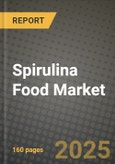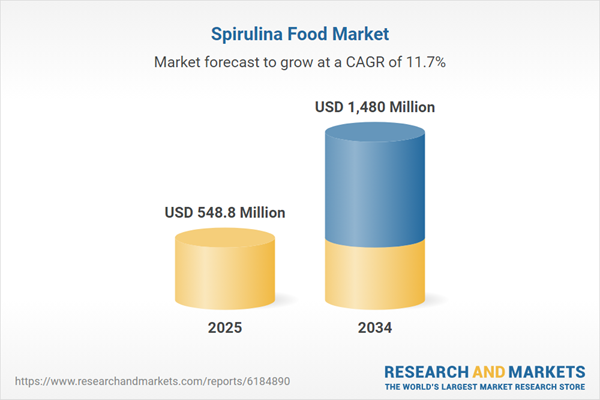Spirulina Food Market
Spirulina has progressed from niche superfood to a mainstream natural ingredient across food categories, prized for its complete protein profile, micronutrient density, and vivid natural coloring - especially phycocyanin, the source of “natural blue.” In foods, top applications span beverages (smoothies, shots, functional waters), confectionery and bakery inclusions, dairy and dairy-alternative formats (yogurts, ice creams), savory snacks, pasta/noodles, breakfast cereals and bars, and sports/active-nutrition foods. Recent trends include clean-label reformulation (replacing synthetic colors and isolated additives), plant-forward protein fortification, sugar-reduced recipes supported by flavor modulators, and Instagram-ready shades (blue, teal, emerald) for limited editions. Drivers include consumer interest in immune support and antioxidant cues, demand for sustainable proteins with low land/water footprints, and retailer pressure for natural color conversion. On the supply side, producers scale both open-pond and photobioreactor systems, tighten HACCP and contaminant controls (heavy metals, microcystins), and invest in de-odorized, neutral-tasting extracts for improved sensory performance. The competitive landscape combines integrated microalgae farmers, specialty color houses, nutrition ingredient suppliers, and private-label co-manufacturers; differentiation centers on purity, color strength, taste neutrality, and documentation for global compliance. Key constraints remain taste masking, heat/pH sensitivity of phycocyanin, and cost-in-use in mass categories, pushing innovation in encapsulation, stabilized emulsions, and process-tolerant complexes. With e-commerce and social content accelerating trial, and large CPGs piloting natural blue and protein-fortified line extensions, spirulina’s role is shifting from “superfood add-in” to a versatile toolkit ingredient enabling color, function, and label appeal across mainstream food portfolios.Spirulina Food Market Key Insights
- From powder to purpose-built ingredients. The market is migrating from bulk powders to application-ready formats - standardized flakes, cold-water dispersible powders, high-purity phycocyanin, and liquid concentrates - reducing variability and simplifying scale-up. Suppliers pair these with technical support on pH, heat, light, and shear to de-risk commercialization in bakery, confectionery, and beverages.
- Color conversion is a durable growth engine. Natural blue remains a hero use case; blends with chlorophylls and curcuminoids unlock sea-green to turquoise palettes. Stabilization via buffers, chelators, and packaging light barriers improves shelf life. Brands leverage limited-edition “aqua” visuals to premiumize launches while meeting retailer mandates to reduce synthetics.
- Protein fortification without grit. Micro-milling, membrane filtration, and agglomeration yield smoother mouthfeel in bars, cereals, and plant-based yogurts. Balanced amino acid profiles support “complete plant protein” claims, while de-flavored variants minimize marine notes. Pairing with oat/pea matrices and fibers improves texture and satiety cues.
- Sensory challenges meet formulation science. Off-notes are addressed through selective extraction, charcoal polishing, and flavor maskers. Encapsulation shields color and bioactives through bake, pasteurization, or UHT, widening use in cookies, filled chocolates, and shelf-stable drinks. Emulsification with clean emulsifiers enhances clarity in beverages.
- Safety, traceability, and specs are make-or-break. Buyers expect tight limits on contaminants, allergen controls, and batch-level certificates. QR-linked traceability and farm-to-formula transparency strengthen retailer acceptance. Third-party audits and robust recall readiness are now standard expectations for large accounts.
- Sustainability story resonates with procurement. Low land and freshwater intensity, alongside opportunities for circular inputs (e.g., CO₂ utilization), support ESG scorecards. Producers publish LCA data and invest in renewable energy at farms. Recyclable/mono-material packaging for ingredient shipments is increasingly requested by global CPGs.
- Cost-in-use managed through potency and process. Higher color strength and improved dispersibility reduce dosage. Process tweaks - late-stage addition, controlled thermal profiles - preserve functionality, cutting waste. Co-development with co-packers aligns batch sizes and minimizes scrap during scale-up.
- Regulatory navigation shapes launch calendars. Compliance for color and novel-food positioning varies by market; suppliers provide region-specific labeling language, additive status, and usage guidelines. Harmonized dossiers expedite approvals and retailer technical onboarding.
- Route-to-market is omnichannel. D2C and specialty e-commerce drive discovery, while mainstream adoption comes via private label and strategic partnerships with confectionery, bakery, and dairy-alt leaders. Culinary collaborations and food-service LTOs (smoothie bowls, “blue” treats) seed demand before retail rollout.
- Pipeline broadens beyond blue. Next-gen offerings include heat-stable blue complexes, lipid-compatible dispersions, protein concentrates with neutral taste, and prebiotic-positioned fibers from cell walls. These expand spirulina from a color/protein additive into a multifunctional platform for clean-label innovation.
Spirulina Food Market Reginal Analysis
North America
Adoption is propelled by natural color swaps in confectionery, frozen desserts, and beverages, plus bar/cereal fortification. Retailers emphasize clean labels and supply transparency, prompting robust specs and contaminant testing. Co-manufacturing capacity supports rapid pilot-to-scale transitions, while food-service LTOs popularize blue and teal concepts. Private label joins branded innovators, broadening shelf presence.Europe
Stringent labeling and retailer standards favor verified purity and lifecycle documentation. Natural blue conversion is active in sugar confectionery and dairy desserts; bakery and pastry use stabilized systems to withstand bake steps. Sustainability narratives (renewables, water stewardship) influence tenders. Regional processors demand heat/pH-tolerant solutions for UHT beverages and shelf-stable applications.Asia-Pacific
APAC combines advanced innovation hubs with fast-growing natural color demand. Japan and Korea drive premium confectionery and bakery aesthetics; Australia and New Zealand expand into better-for-you snacks. In China and Southeast Asia, beverage and dairy-alt launches leverage social commerce and vibrant colorways. Scaled farming and regional extraction improve lead times and cost-in-use.Middle East & Africa
Adoption is led by premium confectionery, ice creams, and smoothie concepts in GCC markets, where natural color conversion aligns with family-friendly positioning. Heat and light stability in shelf displays require protected formulations. Local co-packing and cold-chain investments enable seasonal LTOs. Education on labeling and safe-use specs supports retailer acceptance.South & Central America
Natural color migration advances in confectionery and frozen treats, with growing interest in functional beverages and cereal bars. Localized flavor systems help mask marine notes in tropical profiles. Distributors prioritize consistent potency and technical service for hot-fill and bake-stable formats. Sustainability messaging tied to regional biodiversity and responsible sourcing resonates with retailers.Spirulina Food Market Segmentation
By Type
- Solid Food/Powder
- Beverage
By Application
- Nutrition
- Snack Food
Key Market players
Cyanotech Corporation, DIC Corporation, Chr. Hansen Holding A/S, Sensient Technologies Corporation, Givaudan SA, E.I.D. Parry (India) Limited, Fuqing King Dnarmsa Spirulina Co., Ltd., Prolgae Spirulina Supplies Pvt Ltd., Far East Bio‑Tec Co., Ltd., EnerGaia, Jiangxi Alga Biotech, Hydrolina Biotech Private Limited, Allmicroalgae, eChlorial, NB Laboratories Pvt LtdSpirulina Food Market Analytics
The report employs rigorous tools, including Porter’s Five Forces, value chain mapping, and scenario-based modelling, to assess supply-demand dynamics. Cross-sector influences from parent, derived, and substitute markets are evaluated to identify risks and opportunities. Trade and pricing analytics provide an up-to-date view of international flows, including leading exporters, importers, and regional price trends.Macroeconomic indicators, policy frameworks such as carbon pricing and energy security strategies, and evolving consumer behaviour are considered in forecasting scenarios. Recent deal flows, partnerships, and technology innovations are incorporated to assess their impact on future market performance.
Spirulina Food Market Competitive Intelligence
The competitive landscape is mapped through proprietary frameworks, profiling leading companies with details on business models, product portfolios, financial performance, and strategic initiatives. Key developments such as mergers & acquisitions, technology collaborations, investment inflows, and regional expansions are analyzed for their competitive impact. The report also identifies emerging players and innovative startups contributing to market disruption.Regional insights highlight the most promising investment destinations, regulatory landscapes, and evolving partnerships across energy and industrial corridors.
Countries Covered
- North America - Spirulina Food market data and outlook to 2034
- United States
- Canada
- Mexico
- Europe - Spirulina Food market data and outlook to 2034
- Germany
- United Kingdom
- France
- Italy
- Spain
- BeNeLux
- Russia
- Sweden
- Asia-Pacific - Spirulina Food market data and outlook to 2034
- China
- Japan
- India
- South Korea
- Australia
- Indonesia
- Malaysia
- Vietnam
- Middle East and Africa - Spirulina Food market data and outlook to 2034
- Saudi Arabia
- South Africa
- Iran
- UAE
- Egypt
- South and Central America - Spirulina Food market data and outlook to 2034
- Brazil
- Argentina
- Chile
- Peru
Research Methodology
This study combines primary inputs from industry experts across the Spirulina Food value chain with secondary data from associations, government publications, trade databases, and company disclosures. Proprietary modeling techniques, including data triangulation, statistical correlation, and scenario planning, are applied to deliver reliable market sizing and forecasting.Key Questions Addressed
- What is the current and forecast market size of the Spirulina Food industry at global, regional, and country levels?
- Which types, applications, and technologies present the highest growth potential?
- How are supply chains adapting to geopolitical and economic shocks?
- What role do policy frameworks, trade flows, and sustainability targets play in shaping demand?
- Who are the leading players, and how are their strategies evolving in the face of global uncertainty?
- Which regional “hotspots” and customer segments will outpace the market, and what go-to-market and partnership models best support entry and expansion?
- Where are the most investable opportunities - across technology roadmaps, sustainability-linked innovation, and M&A - and what is the best segment to invest over the next 3-5 years?
Your Key Takeaways from the Spirulina Food Market Report
- Global Spirulina Food market size and growth projections (CAGR), 2024-2034
- Impact of Russia-Ukraine, Israel-Palestine, and Hamas conflicts on Spirulina Food trade, costs, and supply chains
- Spirulina Food market size, share, and outlook across 5 regions and 27 countries, 2023-2034
- Spirulina Food market size, CAGR, and market share of key products, applications, and end-user verticals, 2023-2034
- Short- and long-term Spirulina Food market trends, drivers, restraints, and opportunities
- Porter’s Five Forces analysis, technological developments, and Spirulina Food supply chain analysis
- Spirulina Food trade analysis, Spirulina Food market price analysis, and Spirulina Food supply/demand dynamics
- Profiles of 5 leading companies - overview, key strategies, financials, and products
- Latest Spirulina Food market news and developments
Additional Support
With the purchase of this report, you will receive:- An updated PDF report and an MS Excel data workbook containing all market tables and figures for easy analysis.
- 7-day post-sale analyst support for clarifications and in-scope supplementary data, ensuring the deliverable aligns precisely with your requirements.
- Complimentary report update to incorporate the latest available data and the impact of recent market developments.
This product will be delivered within 1-3 business days.
Table of Contents
Companies Mentioned
- Cyanotech Corporation
- DIC Corporation
- Chr. Hansen Holding A/S
- Sensient Technologies Corporation
- Givaudan SA
- E.I.D. Parry (India) Limited
- Fuqing King Dnarmsa Spirulina Co. Ltd.
- Prolgae Spirulina Supplies Pvt Ltd.
- Far East Bio-Tec Co. Ltd.
- EnerGaia
- Jiangxi Alga Biotech
- Hydrolina Biotech Private Limited
- Allmicroalgae
- eChlorial
- NB Laboratories Pvt Ltd.
Table Information
| Report Attribute | Details |
|---|---|
| No. of Pages | 160 |
| Published | November 2025 |
| Forecast Period | 2025 - 2034 |
| Estimated Market Value ( USD | $ 548.8 Million |
| Forecasted Market Value ( USD | $ 1480 Million |
| Compound Annual Growth Rate | 11.7% |
| Regions Covered | Global |
| No. of Companies Mentioned | 15 |









